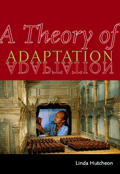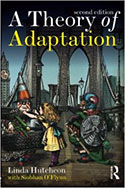

A Theory of AdaptationAre we living in the age of adaptation? In contemporary cinema, of course, there are enough adaptations —based on everything from comic books to the novels of Jane Austen—to make us wonder if Hollywood has run out of new stories. But if you think adaptation can be understood by using novels and films alone, you’re wrong. Today there are also song covers rising up the pop charts, video game versions of fairy tales, and even theme park rides based on successful movie franchises and vice-versa. We constantly tell and retell stories; we show and reshow stories; we interact and re-interact with stories—and these three different modes of engagement (and their interactions) allow us to rethink how adaptation works—and why. Despite their popularity, however, adaptations are usually treated as secondary and derivative. Whether in the form of a Broadway musical or a hit television show, adaptations are almost inevitably regarded as inferior to the “original.” But are they? Shakespeare transferred his culture’s stories from page to stage, and no one begrudged him his borrowing. This study explores the ubiquity and historical persistence of adaptations in all their various media incarnations—and challenges their constant critical denigration. Adaptation, it argues, has always been a central mode of the story-telling imagination and deserves to be studied in all its breadth and range as both a process (of creation and reception) and a product. A Theory of Adaptation theorizes how adaptation works across all media and genres in a way that attempts at last to put an end to the age-old question of whether the book was better than the movie, or the opera, or the theme park. The second, revised edition is supplemented by a new preface, discussing both the new adaptive platforms and recent developments in the study of adaptation. It also features a new epilogue from Siobhan O'Flynn, focusing on adaptation in the context of digital media. She consideres the impact of transmedia practices and properties on the form and practice of adaptation, as well as studying the extension of game narrative across media platforms, fan-based adaptation (from Twitter and Facebook to home movies) and the adaptation of books to digital formats. Table of Contents Preface to the First Edition Preface to the Second Edition Chapter One: Beginning to Theorize Adaptation: What? Who? Why? How? Where? When?
Treating Adaptations as Adaptations Exactly What Gets Adapted? How? Double Vision: Defining Adaptation Adaptation as Product Adaptation as Process Modes of Engagement Framing Adaptation Chapter Two: What? (Forms)
Telling <= => Showing Showing <==> Showing Interacting <==> Telling or Showing Clichés #1 to 4 Learning from Practice Chapter Three: Who? Why? (Adapters)
Why Adapt? The Economic Lures The Legal Constraints Cultural Capital Personal and Political Motives Learning from Practice Intentionality in Adaptations Chapter Four: How? (Audiences)
Knowing and Unknowing Audiences Modes of Engagement Revisited Kinds and Degrees of Immersion Chapter Five: Where? When? (Contexts)
Transcultural Adaptation Indigenization Learning from Practice Why Carmen? The Carmen Story—and Stereotype Indigenizing Carmen Chapter Six: Final Questions
What Is the Appeal of Adaptations? Epilogue References |